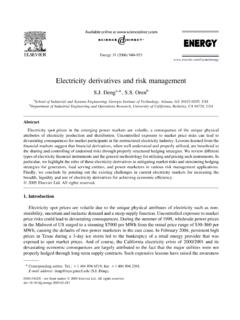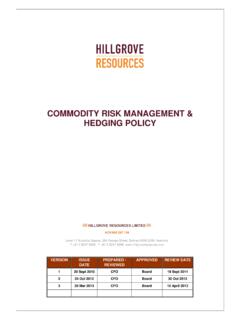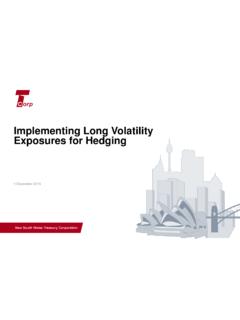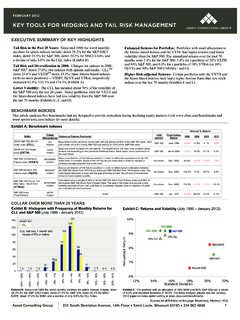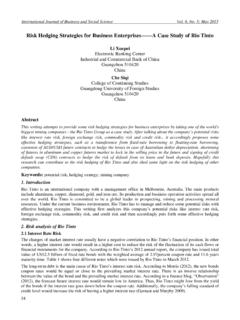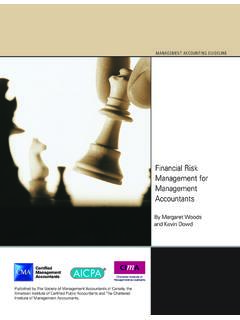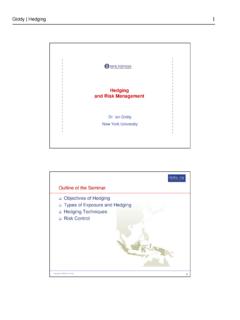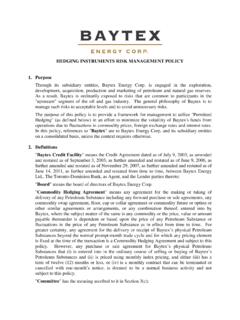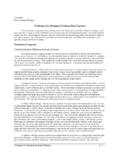Transcription of Foreign Exchange Management policy Objectives and …
1 Foreign Exchange Management policy Objectives and Controls Companies operating in international markets should establish Management policies on Foreign Exchange . The following article provides a framework for developing a comprehensive Foreign Exchange exposure Management policy in the context of the company s financial treasury Objectives , existing business activities, and operating environment. Fluctuations in Foreign Exchange rates affect the cost competitiveness, profitability, and valuation of a company s international operations. The absence of a Foreign Exchange Management policy leaves a company unprepared to control the potential adverse effects of currency movements. This can lead to increased costs and reduced market share and profits.
2 To avoid these exposures, the company should develop and document a policy statement, describing the company s attitude, Objectives , and appropriate responses when managing Foreign Exchange risk. The primary objective is to establish a policy that will minimize the effects of adverse Exchange rate fluctuations on the financial position of the company. Additional benefits of a clearly stated policy include: Involving senior Management in policy formulation to establish clear guidelines and avoid future misunderstandings; Establishing a fair system for evaluating performance of corporate treasury staff; Integrated policy -making, which leads to better, more realistic long-run strategies.
3 It is important to stress that no outside source can establish an optimal policy for individual corporations. Nevertheless, the structure of a policy document tends to be broadly similar, since all companies must address the same major issues in Foreign Exchange Management . The following suggestions are meant to provide a framework for policy development, rather than purporting to be the perfect Foreign Exchange Management system. Exposure Identification and Reporting The starting point for the formulation of an exposure Management program is to decide exactly what the company has at risk. The following exposures are generally considered in developing a Foreign Exchange policy : Transaction exposure: Generally considered to be the income-statement impact of all payables and receivables denominated in Foreign currency.
4 This could include dividends, service fees, royalties, taxes and duties, etc. Translation exposure: Balance sheet exposure that results from the consolidation of financial statements of Foreign entities into the home currency . Corporate Earnings Exposure: Measures the impact of currency movements on the company s targeted after-tax consolidated earnings. Operating Exposure: Reflects the effects of Exchange rate movements on an entity s projected cash inflows and outflows. Economic Exposure: Represents the most all-encompassing definition of exposure. It represents all transactions, assets and liabilities, recorded or anticipated, that will affect the company s cash flow when Exchange rates change.
5 This is usually associated with a longer-term (1-5 year) view of exposure Management . There is no single correct exposure definition, so Foreign Exchange policy will depend on the accounting and cash flow implications of each definition for the company, as well as corporate goals and risk tolerance. It is an obvious truism to suggest that, you cannot manage what is not known. This means that reporting systems are crucial to the entire Management process. Most companies utilize some form of standardized reporting to one central Foreign Exchange Objectives and Controlslocation, unless individual entities are viewed as completely independent. Exposure reporting is a key issue, since treasuries can end up overhedged, underhedged, or unhedged because of inadequate information.
6 Timing is also a key consideration, because market opportunities can slip away while managers wait for information on the direction and size of an exposure. The complexities in defining and reporting appropriate exposures underscore the importance of involving treasury personnel at an early stage of the decision-making process. It is important that the area involved in implementing hedging decisions also be part of the process of defining and reporting exposures. Foreign Exchange Management Objectives and policy Effective Foreign Exchange Management is a financial tool for ensuring the profitability of the company s primary business. As such, the company should prepare a comprehensive policy statement on Foreign Exchange risk that clearly states the company s Objectives , the tactics for attaining these Objectives , and the allocation of responsibility for exercising these tactics.
7 policy Formulation A key requirement when establishing a comprehensive policy for managing Foreign Exchange exposure is to ensure that the tenets, Objectives and procedures set forth in the policy are consistent with the company's existing policies towards the return on Foreign investment, and that these procedures meet the need to minimize the negative effects of currency fluctuations on the company s consolidated earnings position. While the operating philosophy and financial goals of each corporation vary, an effective policy statement for the day-to-day Management of Foreign Exchange risk will cover the following critical parameters: A. Definition of Objectives ; B. Ranking of exposure priorities; C.
8 Establishment of risk thresholds; D. Allocation of treasury responsibility for exposure Management ; E. Development of specific guidelines for control and reporting requirements. A. Definition of Objectives Having identified its Foreign Exchange exposures, the company should be aware of the Exchange rate impact on all aspects of its operations. Hence, the Objectives established should reflect Management s tolerance and attitude toward Foreign Exchange risk and should be clearly stated in the policy . Generally, these Objectives fall into two groups: financial Objectives and protection Objectives . 1. Examples of Financial Objectives : Primary: To take all reasonable steps to minimize losses resulting from consolidated earnings exposure.
9 Secondary: To fund worldwide operations at the lowest after-tax cost; To ensure liquidity for worldwide operations and maintain access to local credit markets; To protect assets worldwide; To maximize US dollar profits from overseas operations. While this is not an exhaustive list, it provides some examples to illustrate the point. 2. Examples of Protection Objectives : The company should not hedge its position in a currency when the following conditions prevail: The risk of loss is minimal; The cost of covering the position is prohibitive; The means for covering the position are unavailable in the market. Management should be responsible for ensuring that any action taken to decrease exposure is economically justifiable on an after-tax basis.
10 Protection Objectives typically state when not to hedge, and can be expressed in qualitative or quantitative terms. For example, prohibitive cost could be specified in dollar terms, or it could be left open to interpretation by an appropriate manager designated in the policy . The main point is to avoid hedging decisions being made without regard to cost and efficiency. Foreign Exchange Objectives and ControlsB. Ranking of Exposure Priorities The company should rank the types of exposures that it faces as a result of fluctuating Exchange rates according to their importance to financial, operating and senior Management . This prioritization serves as the basis for focusing exposure Management efforts and deciding which protective actions the company should employ.



